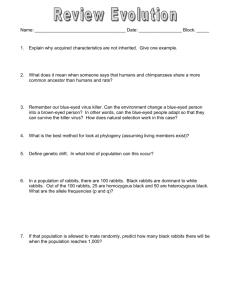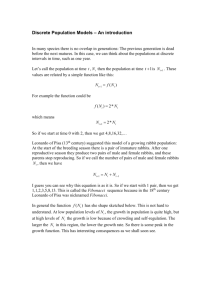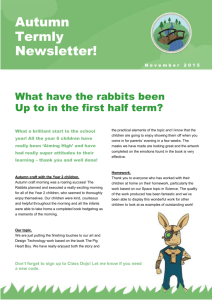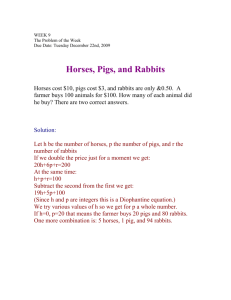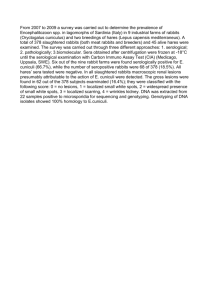00/99 final cond commercial rabbits
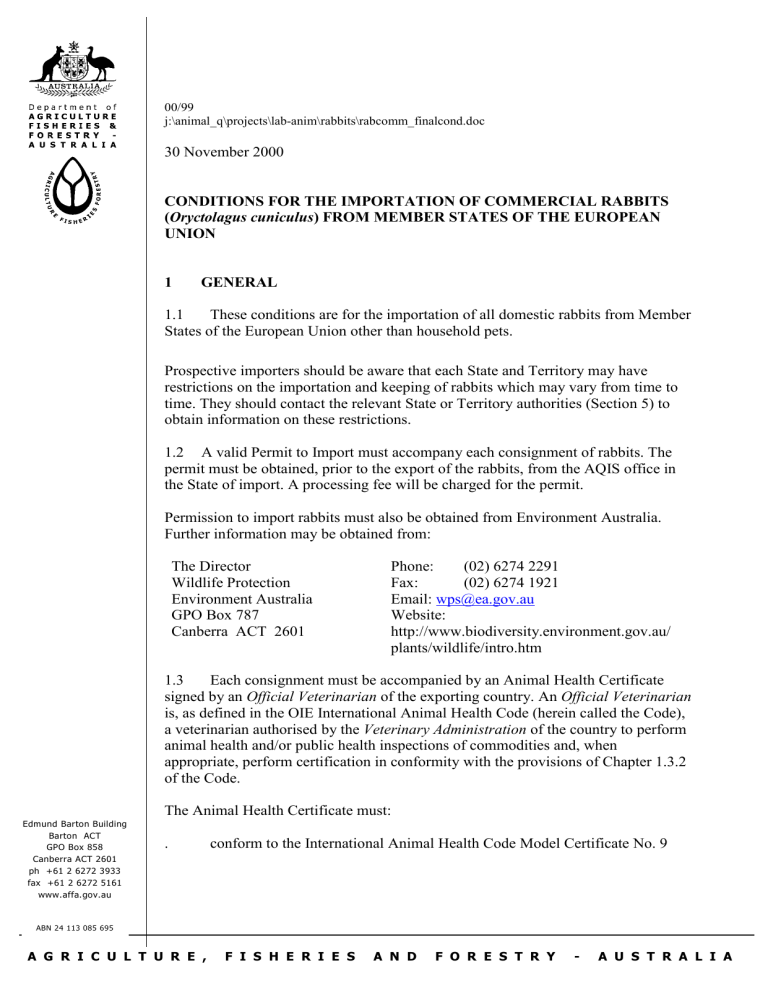
00/99 j:\animal_q\projects\lab-anim\rabbits\rabcomm_finalcond.doc
30 November 2000
CONDITIONS FOR THE IMPORTATION OF COMMERCIAL RABBITS
( Oryctolagus cuniculus ) FROM MEMBER STATES OF THE EUROPEAN
UNION
1 GENERAL
1.1 These conditions are for the importation of all domestic rabbits from Member
States of the European Union other than household pets.
Edmund Barton Building
Barton ACT
GPO Box 858
Canberra ACT 2601 ph +61 2 6272 3933 fax +61 2 6272 5161 www.affa.gov.au
.
Prospective importers should be aware that each State and Territory may have restrictions on the importation and keeping of rabbits which may vary from time to time. They should contact the relevant State or Territory authorities (Section 5) to obtain information on these restrictions.
1.2
A valid Permit to Import must accompany each consignment of rabbits. The permit must be obtained, prior to the export of the rabbits, from the AQIS office in the State of import. A processing fee will be charged for the permit.
Permission to import rabbits must also be obtained from Environment Australia.
Further information may be obtained from:
The Director Phone: (02) 6274 2291
Wildlife Protection
Environment Australia
GPO Box 787
Canberra ACT 2601
Fax:
Email:
Website:
(02) 6274 1921 wps@ea.gov.au
http://www.biodiversity.environment.gov.au/ plants/wildlife/intro.htm
1.3 Each consignment must be accompanied by an Animal Health Certificate signed by an Official Veterinarian of the exporting country. An Official Veterinarian is, as defined in the OIE International Animal Health Code (herein called the Code), a veterinarian authorised by the Veterinary Administration of the country to perform animal health and/or public health inspections of commodities and, when appropriate, perform certification in conformity with the provisions of Chapter 1.3.2 of the Code.
The Animal Health Certificate must: conform to the International Animal Health Code Model Certificate No. 9
ABN 24 113 085 695
A G R I C U L T U R E , F I S H E R I E S A N D F O R E S T R Y - A U S T R A L I A
. provide details of the certifying authority, identification, place of origin and approved pre-export isolation facility, exporter and consignee, destination and means of transport
. contain the certification details listed in Section 2 of this document.
1.4 Each rabbit must be identified by ear tattoo or by an ISO compatible transponder (microchip) prior to export. The identifying tattoo number, or the microchip number and implantation site, must be recorded on the Animal Health
Certificate.
1.5 The animals must be consigned to Australia by a route approved by the
Australian Director of Quarantine (herein called the Director). They may be accompanied by other animals only with the approval of the Director. They may only be transhipped en route with the approval of the Director. Approval from the relevant authority will also be required in countries of transit and transhipment.
1.6 In the event of rabbits arriving in Australia without the correct certification, or in any other way not having met these requirements, they may be retained in quarantine, returned to the country of origin or destroyed without recompense.
1.7 Fees may be applied by AQIS to cover costs associated with the quarantine and any Australian Government veterinary supervision of the consignment.
1.8 Conditions of importation may be varied or reviewed at any time at the discretion of the Director.
2 CERTIFICATION
The Official Veterinarian must certify, under IV. Sanitary information of the
Animal Health Certificate, in relation to the rabbits described in Part 1 of the
Certificate, that:
2.1 After due enquiry he/she is satisfied that each rabbit for export was born and has been continuously resident on the property of origin (pre-export quarantine isolation facility) or the property of origin prior to entering the pre-export quarantine isolation facility (described in Clause 2.4 below). The resident colony (on the property of origin) is housed in accommodation that precludes access by wildlife, including rodents, and is free of infestation with ticks. The colony is either closed or else records are maintained of the origin of all rabbits and their dates of introduction.
2.2 After due inquiry he/she is satisfied there has been no clinical evidence of the following diseases in the animals destined for export or in any lagomorphs on the property of origin or pre-export quarantine isolation facility during the 12 months
. prior to export:
. rabbit haemorrhagic disease (calicivirus) myxomatosis commercial rabbits quarantine requirements 2
A G R I C U L T U R E , F I S H E R I E S A N D F O R E S T R Y - A U S T R A L I A
.
.
. tularaemia (caused by treponematosis (caused by sylvatic plague
Francisella tularensis
(caused by Yersinia pestis )
)
Treponema cuniculi )
. European brown hare syndrome.
2.3 After due enquiry he/she is satisfied that, on the property of origin:
. that no outbreak of epizootic rabbit enterocolitis (ERE) has occurred during the 3 years prior to export
.
. disease outbreaks are routinely investigated and detailed records kept antibiotics are not routinely used either in the feed or the drinking water.
Rabbits may either be exported to Australia as “1 day old” (1 to 3 days of age) rabbits or weaned rabbits (see Figures 1 and 2) under the following conditions
.
Option 1 – export of “1 day old” rabbits
2.4
The rabbits for export to Australia were conceived and born in a pre-export quarantine isolation facility, which is either the property of origin or part thereof approved by the Veterinary Administration of the exporting country for holding animals for export to Australia, and either the animals in quarantine were isolated by a minimum distance of 50 metres from all other lagomorphs not of equivalent approved health status, or they were maintained in strict isolation in a facility separated by solid walls from all other lagomorphs not of equivalent approved health status
.
. the isolation facility is rodent-proofed the isolation facility is insect-protected and the water supply is treated with chlorine to a level of 1.5 mg “available chlorine”/L or with an equivalent disinfectant
. an Official Veterinarian was responsible for supervision of the quarantine.
2.5 The breeding does and bucks, if natural mating used, were maintained in the pre-export isolation facility for at least 4 weeks prior to mating until the export of the kits.
2.6 The rabbits for export, their dams and, their sires have undergone the following pre-export quarantine regimen under the supervision of scientists/institute approved by AQIS. commercial rabbits quarantine requirements 3
A G R I C U L T U R E , F I S H E R I E S A N D F O R E S T R Y - A U S T R A L I A
2.6.1 Specific pathogen free (SPF) sentinel rabbits were placed in cages adjacent to cages containing the breeding does and, if natural mating was used, the bucks to which the does were mated. There was at least one sentinel to every 10 does, with a minimum of 20 sentinels. The rabbits were observed for four weeks. Following the period of observation, the rabbits were mated and kept with fresh, newly-introduced
SPF sentinels. SPF sentinels were introduced every 4 weeks until the export of the kits.
. if breeding does were mated by artificial insemination, SPF sentinel rabbits were placed in cages adjacent to the bucks from which the semen has been obtained. There was at least one sentinel to every 10 bucks, with a minimum of 20 sentinels. The rabbits were observed for four weeks.
Note - SPF sentinels must be obtained from an AQIS approved facility (for example
INRA SPF breeding facility) and certified to meet clauses 2.1, 2.2 and 2.3.
2.6.2 If the pre-export isolation facility is only part of the property of origin a further 20 SPF sentinels were placed on the remaining part of the property of origin, alternatively in maternity cages and cages containing breeding does. Fresh sentinels were added every four weeks, for at least a period of eight weeks until the kits for export were exported to Australia. The rabbits were observed throughout this period.
2.6.3 Straw or hay was not used in the cages or nesting boxes in the pre-export isolation facility.
2.6.4 During the entire period of pre-export isolation strict sanitary measures were applied to prevent the entry of pathogens into the pre-export isolation facility.
.
.
.
.
Personnel attending the animals and any other person entering the facility either did not have contact with lagomorphs outside the facility or showered and changed clothing on each occasion of entry to the facility. Clean protective clothing was
. dedicated to use within the facility.
2.6.5 During the entire period of monitoring with sentinels (ie during pre-export isolation and on the property of origin (if required)): no antibiotics were given in either food, drinking water or by direct inoculation all rabbits were inspected at least once a day all dead rabbits were removed from the isolation facility and property of origin and all, other than neonates, were autopsied all rabbits with diarrhoea were removed from the isolation facility and property of origin, sacrificed and autopsied all autopsies were performed by a veterinary surgeon with specific knowledge and experience in the pathology of rabbits; in cases where lesions were suspicious for ERE, intestinal contents were forwarded to a laboratory approved commercial rabbits quarantine requirements 4
A G R I C U L T U R E , F I S H E R I E S A N D F O R E S T R Y - A U S T R A L I A
by AQIS and recognised as being skilled at the diagnosis of ERE, and inoculated by mouth into SPF rabbits
. records were maintained containing zootechnical data of the rabbit breeding: number of does, males, date of littering, number of kits born (alive and dead), date of weaning, mortalities before and after weaning.
The results of the observations, autopsies and tests gave no indication that ERE was present.
Note - during the two days prior to export, adequate measures must be taken to ensure that the kits suck to satiety.
OR
OPTION 2 - export of weaned rabbits (less than 12 weeks of age)
2.7 The rabbits for export, their dams, foster dams and, their sires have undergone the following pre-export quarantine regimen under the supervision of scientists/institute approved by AQIS.
2.7.1 Specific pathogen free (SPF) sentinel rabbits were placed in cages adjacent to cages containing the breeding does and, if natural mating was used, the bucks to which the does were mated. There was at least one sentinel to every 10 does, with a minimum of 20 sentinels. The rabbits were observed for four weeks. Following the period of observation, the rabbits were mated and kept with fresh, newly-introduced
SPF sentinels. SPF sentinels were introduced every 4 weeks until the removal of the kits to the pre-export isolation facility.
. if breeding does were mated by artificial insemination, SPF sentinel rabbits were placed in cages adjacent to the bucks from which the semen has been obtained. There was at least one sentinel to every 10 bucks, with a minimum of 20 sentinels. The rabbits were observed for four weeks.
Note - SPF sentinels must be obtained from an AQIS approved facility (for example
INRA SPF breeding facility) and certified to meet clauses 2.1, 2.2 and 2.3.
2.7.2 The 1 day old kits were removed from their dams and introduced to a preexport quarantine isolation facility (described in Clause 2.4 above), approved by the
Veterinary Administration of the exporting country for holding animals for export to
Australia. The 1 day old kits were adopted by SPF laboratory does (foster dams).
All the kits must be sourced from the one property of origin.
.
SPF sentinel rabbits were placed in cages adjacent to the kits and foster dams.
There was at least one sentinel to every 10 kits, with a minimum of 20 sentinels. Fresh sentinels were added every four weeks, until the kits were exported to Australia. The rabbits were observed throughout this period. commercial rabbits quarantine requirements 5
A G R I C U L T U R E , F I S H E R I E S A N D F O R E S T R Y - A U S T R A L I A
. SPF laboratory does (foster dams) must be obtained from a property certified to meet clauses 2.1, 2.2 and 2.3 and be of a known, monitored health status, and have been maintained under barrier conditions. SPF sentinel rabbits were placed adjacent to the SPF laboratory does and observed for 4 weeks before the laboratory does (foster dams) were placed in the pre-export isolation facility to adopt the kits. There was at least one sentinel to every 10 SPF laboratory does (foster dams), with a minimum of 20 sentinels.
2.7.3 Straw or hay was not used in the cages or nesting boxes of the breeding and foster does.
.
2.7.4 During the entire period of monitoring with sentinels (ie on the property of origin of the breeding does and SPF laboratory does and during pre-export isolation), strict sanitary measures were applied to prevent the entry of pathogens into the preexport isolation facility and property of origin. Personnel attending the animals and any other person entering the facility either did not have contact with lagomorphs outside the facility or showered and changed clothing on each occasion of entry to
.
.
. the facility. Clean protective clothing was dedicated to use within the facility.
2.7.5 During the entire period of monitoring with sentinels (ie on the property of origin of the breeding does and SPF laboratory does and during pre-export isolation): no antibiotics were given in either food, drinking water or by direct inoculation all rabbits were inspected at least once a day all dead rabbits were removed from the isolation facility and property of origin and all, other than neonates, were autopsied all rabbits with diarrhoea were removed from the isolation facility and property of origin, sacrificed and autopsied
. all autopsies were performed by a veterinary surgeon with specific knowledge and experience in the pathology of rabbits; in cases where lesions were suspicious for ERE, intestinal contents were forwarded to a laboratory approved by AQIS and recognised as being skilled at the diagnosis of ERE, and inoculated by mouth into SPF rabbits
. records were maintained containing zootechnical data of the rabbit breeding: number of does, males, date of littering, number of kits born (alive and dead), date of weaning, mortalities before and after weaning.
The results of the observations, autopsies and tests gave no indication that ERE was present. commercial rabbits quarantine requirements 6
A G R I C U L T U R E , F I S H E R I E S A N D F O R E S T R Y - A U S T R A L I A
Certification applicable to all rabbit exports
2.8 There has been no clinical evidence of snuffles (caused by Pasteurella multocida ) or encephalitozoonosis (caused by Encephalitozoon cuniculi ) in animals in the approved pre-export isolation facility during pre-export isolation.
2.9 After due inquiry and in accordance with a written declaration from the owner/agent, he/she is satisfied that the rabbits destined for export have not been vaccinated for myxomatosis prior to export.
2.10 During pre-export quarantine isolation each dam of the rabbit for export (in the case of juvenile rabbits this includes their biological dam and foster dam), was subjected to a serological test for rabbit haemorrhagic disease using an indirect or competitive enzyme linked immunosorbent assay (ELISA) at an approved laboratory with negative results or
During the 6 months prior to export each of their dams (in the case of juvenile rabbits this includes their biological dam and foster dam), was vaccinated for rabbit haemorrhagic disease using an approved inactivated vaccine.
2.11 In the case of juvenile rabbits for export during the four days immediately prior to export, each animal was subjected to treatment with an external parasiticide effective against ticks, mites and fleas, specifically ............................ (product name, active ingredient/s and dose rate used). or
During the four days immediately prior to export, each animal in the approved pre-export isolation facility was thoroughly examined for external parasites and found to be free.
2.12 He/she has examined each rabbit for export during the 24 hours immediately prior to export and found it to be clinically healthy and free from evidence of infectious or contagious diseases, palpable skin tumours or swellings and external parasites, and fit to travel.
.
.
2.13 After due enquiry he/she is satisfied that:
. the containers carrying the animals will be new and unused during transport to the port of export the rabbits will have no contact with animals not eligible for export to Australia the design of the containers, the recommended species requirements and the preparation for transport will be in accordance with the recommendations of the Animal Health Code and International Air Transport Association (IATA)
Live Animals Regulations, or meet alternative requirements specified by
AQIS. commercial rabbits quarantine requirements 7
A G R I C U L T U R E , F I S H E R I E S A N D F O R E S T R Y - A U S T R A L I A
3 IMPORTER’S/ AGENT’S RESPONSIBILITIES
3.1 It is the responsibility of the importer or importer’s agent to ensure all import requirements are met including these requirements and those of other agencies whether Commonwealth (eg Environment Australia), State or industry.
3.2 It is the responsibility of the importer or importer’s agent to arrange for tests and/or certification for diseases additional to those described in Section 2 and, if required, for vaccination of animals in quarantine with an AQIS-approved inactivated vaccine for rabbit haemorrhagic disease.
3.3 The importer or agent must nominate a person who can be contacted by AQIS officers during the import process and while the animals are in quarantine or under quarantine surveillance.
3.4 The importer or agent is responsible for ensuring that the Australian
Government is paid for services provided. The Government will not recompense the importer or agent for any losses incurred while the animals are under AQIS control.
4 POST ARRIVAL CONTROLS
4.1 Each consignment of imported animals must undergo post arrival quarantine
(PAQ) in a Government animal quarantine station or other AQIS-approved and supervised premises for a minimum period of 60 days. During PAQ the animals must be housed in rodent-proofed and insect protected accommodation. Personnel in contact with the imported animals must not have any contact with other lagomorphs during the PAQ period.
4.2 During PAQ all animals will be examined daily by a competent person for any signs of sickness. Any sickness or death will be reported immediately to the
Principal Quarantine Officer (Animals) in that State and details recorded. As far as possible, the cause will be established to the extent of excluding those diseases listed in Section 2.2 and 2.3 of this document.
4.3 During the four days immediately prior to release from quarantine, each animal must be subjected to treatment with an external parasiticide effective against ticks mites and fleas.
4.4 All rabbits must be examined by an AQIS veterinarian immediately prior to release from quarantine and be clinically healthy and free from evidence of infectious or contagious diseases and external parasites.
4.5 At the completion of PAQ the rabbits will be released under quarantine surveillance at an AQIS approved and supervised premises. Any progeny of imported rabbits will be under quarantine surveillance while the imported animals are under surveillance. While under quarantine surveillance, the animals must be isolated from all other lagomorphs by a minimum distance of 50 metres, or be separated by solid walls from all other lagomorphs, and under such conditions as are commercial rabbits quarantine requirements 8
A G R I C U L T U R E , F I S H E R I E S A N D F O R E S T R Y - A U S T R A L I A
prescribed by AQIS. They will remain under quarantine surveillance for 12 months or for such period as the Director specifies.
4.6 During PAQ, and while under quarantine surveillance, the animals may be subjected to any testing or treatment prescribed by the Director, at the importer’s expense.
4.7 If any animal fails a test or shows signs of disease during PAQ or while under quarantine surveillance, that animal and any or all other animals in the same premises may be detained in quarantine for further testing and/or observation, or exported at the importer's expense, or destroyed without recompense.
5 ATTACHMENT
State / Territory authorities that should be contacted prior to importing rabbits:
Queensland - Department of Natural Resources
South Australia - Animal and Plant Control Commission
Northern Territory - Department of Primary Industry and Fisheries
Western Australia - Agriculture Western Australia
Victoria - Department of Natural Resources and Environment
New South Wales - NSW Agriculture, Animal Industries, Orange
Tasmania - Department of Primary Industries, Water and the Environment
DAVID BANKS
Acting General Manager
Animal Biosecurity commercial rabbits quarantine requirements 9
A G R I C U L T U R E , F I S H E R I E S A N D F O R E S T R Y - A U S T R A L I A
Figure 1 Option 1: export of one-day-old rabbits
Property of
Origin
Does selected
Does introduced into
PEQ
(4 weeks before mating)
Mating
Pre-export quarantine (PEQ) facility
(all or part of the property of origin)
Gestation
Birth
Export of one-day-old kits
Monitoring with sentinels
Fresh sentinels introduced every 4 weeks
If only part of the property of origin is the
PEQ facility, the remainder to be monitored with sentinels for at least 8 weeks until export of commercial rabbits quarantine requirements 10
A G R I C U L T U R E , F I S H E R I E S A N D F O R E S T R Y - A U S T R A L I A
Figure 2 Option 2: export of weaned rabbits
Breeding
Does
Foster Does
(Laboratory)
Does selected
Does selected
Pre-mating monitoring
(4 weeks)
Monitoring with sentinels
Fresh sentinels introduced every 4 weeks
Monitoring
(4 weeks)
Property of origin
(breeding does)
Mating
Gestation
Property of origin
(foster does)
Birth
One-day-old kits
Pre-export quarantine facility
Adoption of kits by foster does
Export of juvenile weaned rabbits
Monitoring with sentinels
Fresh sentinels introduced every 4 weeks commercial rabbits quarantine requirements 11
A G R I C U L T U R E , F I S H E R I E S A N D F O R E S T R Y - A U S T R A L I A

